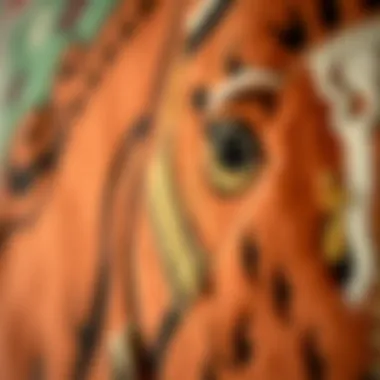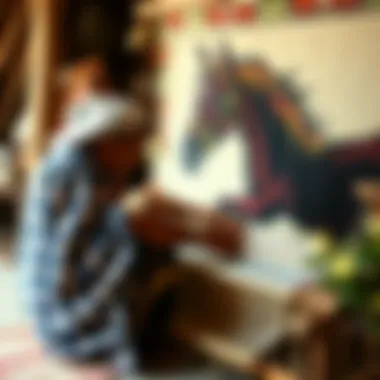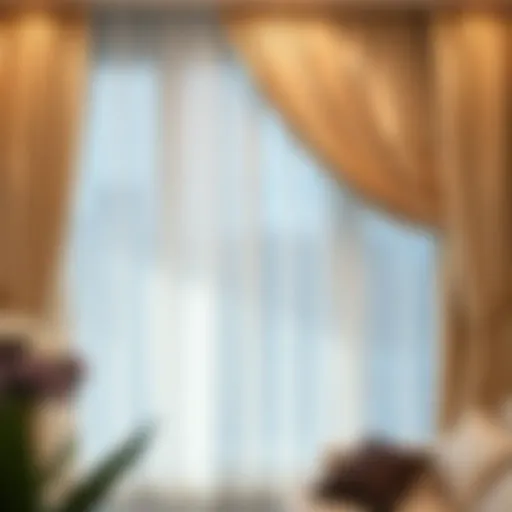Exploring Horse Tapestry Wall Hangings in Decor


Intro
The world of horse tapestry wall hangings brings forth a narrative woven through history, art, and culture. These textiles are more than mere décor; they embody the stories of the horses, their riders, and the artistry of skilled craftsmen. It’s a realm where vibrant colors and intricate patterns meet the aesthetic sensibilities of today’s interiors. As we navigate through this article, we will explore how horse tapestries have evolved over the centuries, their remarkable craftsmanship, and how they can transform modern spaces into havens of elegance and character.
Whether one is a collector, a designer, or simply an aficionado of textile arts, the tapestry of horse motifs offers countless layers to appreciate. From the intricate weaves that speak to the artisan’s technique to the rich symbolism that resonates with those who have an affinity for equestrian culture, there's much to uncover and admire. Our journey will not only touch on the artistic aspects but extend to practicalities, helping enthusiasts maintain these pieces to ensure freshness and longevity in their homes.
Fashion Trends
Latest Seasonal Trends
Horse tapestry wall hangings have seen a recent resurgence in popularity, particularly amongst stylists and home décor enthusiasts. As individuals increasingly seek ways to personalize their spaces, these textiles offer warmth and a unique storytelling element. This season, expect to see muted earth tones paired with vibrant horse imagery, reflecting a connection to nature and sustainable living. Designers are favoring pieces that blend classical aesthetics with modern sensibilities, as seen in collections that juxtapose contemporary minimalism with rich historical narratives.
Moreover, layering of tapestries, alongside other textiles, is gaining traction. This approach allows for a rich depth in stimulation—different textures and colors harmoniously coexisting. For example, a large horse tapestry can serve as the focal point over a neutral sofa, complemented by an array of smaller cushions that echo its hues. This balancing act creates a lively interplay, enhancing the home’s visual landscape.
Iconic Styles Revived
Several iconic styles are resurfacing in the world of horse tapestries. One notable example is the revival of traditional Flemish designs, known for their meticulous detail and bold imagery. These pieces often feature mythical scenes or pastoral landscapes, invoking a sense of nostalgia and whimsy. Meanwhile, more contemporary interpretations lean into abstract representations, exploring the essence of horses through shapes and colors rather than realistic portrayals.
Craftsmanship plays a pivotal role in these revived iconic styles. Each tapestry reflects the skill of the weaver, often taking months—or even years—to complete. Collectors appreciate the rarity and unique character of each piece, setting them apart from mass-produced wall art.
“The artistry of tapestry weaving rests not only in the creation of beautiful images but also in the storytelling embedded within each fiber.”
As we look at these trends, it becomes apparent that horse tapestry wall hangings are not just decorative items, but aesthetic experiences intertwined with personal narratives and cultural heritage.
Moving on, our next exploration will be the nuances of integrating these art pieces into one's own space.
The Historical Significance of Tapestry
Tapestries have been woven into the very fabric of history, serving not just as decorative items but also as narratives of societal identity. Their significance transcends mere aesthetics; they encapsulate cultural heritage, economic conditions, and social standards of their times. Horse tapestry wall hangings, in particular, echo ideas of strength, freedom, and beauty, making them an enduring subject of interest.
Tapestry in history represents an art form that involves intricate labor and skilled craftsmanship. Each piece tells a story, preserving moments frozen in time. As you delve deeper into the realm of tapestry, you discover not just art, but the intertwining of culture and function. When it comes to horse motifs, there is a rich narrative, revealing the relationship between humans and these majestic animals throughout different epochs.
"Tapestries are not merely decorations, they are historical dialogues bridging the past to the present."
Origins of Tapestry Weaving
The roots of tapestry weaving can be traced back to ancient civilizations. The earliest known examples are found in the Minoan culture on the island of Crete around 1500 B.C. They were extensively used to not only cover walls but also to tell myths and legends that shaped the identities of nations. Fast forward to the Middle Ages, and you’ll see how tapestries transformed into expressions of power and wealth, often commissioned by royalty, showcasing large battles or intricate scenes with horses at the forefront.
In this period, the art of weaving became a collaborative skill, bringing together artists, weavers, and merchants. Different regions began to develop their unique styles, with Belgium and France taking the lead. The tapestries produced became prized possessions, often serving as heirlooms, thus highlighting their significance. They acted as insulation for stone walls, while simultaneously acting as status symbols, crowning castles and grand homes across Europe.
Tapestries in Different Cultures
Horse tapestries exist in diverse cultures, each telling distinct stories shaped by their surrounding environments. In the Chinese culture, horses symbolize success and loyalty. Tapestries reflecting these themes often depict horses galloping free, underscoring movement and power, resonating with the ideals of prosperity. The Native American cultures employ horse imagery in their tapestries to represent freedom and the spirit of nature, deeply tying these magnificent beings to their personal narratives.
In Europe, tapestries often portray horses in the context of chivalry. The noble steeds highlight not only status but also valor in battle. This portrayal can be seen in pieces from the 15th century, where horses are depicted in grand tapestries amidst heraldic symbols. Thus, the types and techniques of tapestry weaving expose a global understanding of horses, reflecting differing attitudes towards these animals, and their varied roles in society.
Exploring Horse Iconography
Symbolism of Horses in Art
The symbolism of horses in art stretches far beyond mere representation. Throughout history, horses have signified power, grace, and freedom across various cultures. In tapestry wall hangings, horses often symbolize not just transportation but deeper themes like nobility and endurance. When depicting horses, an artist might choose a galloping stallion to signify vigor, or a serene mare to represent nurturing qualities. This duality showcases the horse's multifaceted role in human life.
Moreover, horse imagery often captures emotional states. For instance, a herd of horses in motion can evoke feelings of unity or chaos, depending on the composition. When horse tapestries adorn a wall, they become more than decorative items; they tell stories, embodying the values and aspirations of the cultures that created them.
In many artworks, especially those from regions with rich equestrian traditions, horses are depicted with intricate details — the musculature, the flowing manes, and the expressions that convey strength or tranquility. Such representations enhance the tapestry's narrative quality, pulling the viewer into a world where each thread weaves a tale of its own.
Cultural Depictions of Horses
Horses occupy a prominent space in various cultural narratives, often revered as sacred creatures. In ancient Greek art, for example, horses are depicted in mythical contexts, such as the winged Pegasus. This imagery reflects the belief that horses are not merely animals but symbols of divine message and inspiration.
Over in Asia, particularly in Chinese culture, the horse is seen as a symbol of success and perseverance. Artworks, including tapestries, often showcase horses in auspicious settings, representing good fortune and vitality. Similarly, Native American tribes have utilized horses symbolically in their crafts, conveying values such as bravery and freedom.


From these perspectives, horse tapestries uniquely encapsulate the ethos of their respective cultures. Common depictions might include equestrians engaged in a chase or horses at rest in pastoral settings, each rendition telling its own cultural story. Recognizing these intricate cultural narratives enhances appreciation for horse tapestries, making them not only decorative art pieces but also vessels of historical and cultural significance.
"Horses in art are more than design choices; they embody stories, values, and traditions that withstand the test of time."
In summary, understanding the symbolism and cultural depictions of horses in tapestries allows collectors and enthusiasts to engage with these artworks on a deeper level. It underscores how these creations are not just fabric but woven legacies that connect us with our past and inspire future generations.
Craftsmanship and Techniques
The realm of horse tapestry wall hangings is not just a mere assembly of threads and colors; it is a rich tapestry of artistry and painstaking craftsmanship. This meticulous process encapsulates not only the technical skill of the artisan but also their profound understanding of art, heritage, and cultural significance. The craftsmanship behind these textiles ensures both durability and aesthetic appeal, making it essential for any enthusiast or collector to grasp its nuances.
Weaving Techniques Used
When it comes to weaving techniques, tapestry-making is a complex interplay of several methods. Most notably, the Jacquard weaving technique has carved a niche in the creation of intricate designs, allowing for tight integration of colorful threads. This technique uses a special loom, making it easier to produce detailed patterns and images, including the majestic forms of horses.
A few other noteworthy methods include:
- Flat-weave: Often utilized for its flexibility, this approach results in a thinner tapestry, which is perfect for more subtle designs.
- Kilims: This ancient technique, typically involving a combination of weaving and embroidery, adds dimensionality to the overall piece.
- Tapestry weaving: This traditional method demands a time-intensive approach where each thread is individually set on the loom, allowing for a wide array of colors and textures.
Understanding these techniques can deeply enhance one’s appreciation for the craftsmanship behind horse tapestries, as the choice of weave directly influences the tapestry's texture and longevity.
Color Theory in Tapestry Art
Color plays a pivotal role in tapestry artistry. The choice of hues can alter the viewer's emotional response to the piece, thus making color theory extremely relevant for creators. Horse-themed tapestries often utilize a palette that reflects the natural environment — earthy browns, lush greens, and soft blues, creating a harmonious visual experience.
Key aspects of color use in tapestries include:
- Warm vs. cool colors: Warm colors like reds and yellows evoke energy and vibrancy. In contrast, cool colors provide feelings of calm and balance. Finding the right mix can drastically affect how the tapestry is percieved within a space.
- Contrast and Dominance: Artists must pay careful attention to contrast; a well-placed splash of a bold color against a more subtle background can make a singular element—like a galloping horse—pop out.
- Symbolism: Different colors have varied associations. For instance, blue might symbolize tranquility, while red could represent passion or power. Understanding these associations allows artisans to convey deeper meanings in their work.
Design Process of Tapestries
Creating a horse tapestry is a journey that begins long before the first thread is woven. The design process incorporates initial ideation, sketching, and frequent revisions. Artists often draw inspiration from a variety of sources, including nature, history, and even personal experiences. This stage is crucial, serving as the foundation upon which the tapestry will be built.
The design process typically includes:
- Research: Understanding the historical context and significance of the depiction can influence design choices greatly.
- Sketching: Initial sketches are created, often incorporating various elements that will later be woven into the tapestry.
- Color Mapping: After the initial design, artisans select a color scheme that reflects the emotions and themes behind the work.
- Scale Models: Sometimes, artists will create smaller versions of their designs to evaluate how they translate in tapestry form.
- Final Planning: Plans are finalized before the loom is set, establishing a clear roadmap for the actual weaving process.
"Design is not just what it looks like and feels like. Design is how it works." - Steve Jobs. This quote resonates deeply within the tapestry world, where function and beauty must harmonize.
Understanding craftsmanship and techniques enriches appreciation for horse tapestry wall hangings, allowing both creators and collectors alike to engage with these artworks on a more profound level.
Materials in Horse Tapestry
Understanding the materials used in horse tapestry is as vital as grasping its historical significance or its cultural impact. The choice of materials determines not just the tapestry's texture and visual appeal, but also its durability and overall value. In this realm of artistry, these textiles are often a reflection of the environment and resources available in the weaver's locality. The materials selected play a critical role in conveying artistic vision and ensuring the longevity of the piece.
Types of Yarn and Threads
The yarn and threads are the backbone of any tapestry. Various types of materials can be used, each contributing unique qualities to the final creation. Commonly used fibers include:
- Wool: Popular for its warmth and durability, wool offers a rich texture and is often dyed with vibrant colors, which can significantly enhance the intricate horse designs.
- Cotton: Known for its softness and easy dyeing, cotton is a great choice for fine details. It’s less durable than wool, but it allows for intricately woven images.
- Linen: Made from the flax plant, linen has a distinct natural sheen and can create a slightly crisp texture. It often holds color well and gives a more luxurious feel to the tapestry.
- Silk: Though not as commonly used due to cost, silk adds a beautiful sheen and a smooth finish. It is often utilized in special commissioned pieces or high-end artworks.
When selecting materials, consider the intended use and environment of the tapestry. For instance, if it is meant for display in a sunny area, colorfastness becomes a critical requirement to prevent fading.
Durability and Care of Materials
Durability is paramount since tapestries are often subjected to various environmental factors. The choice of fibers directly correlates to how well the tapestry withstands wear and tear. Wool, for instance, is known for being resilient, making it suitable for high-traffic areas. However, other materials like cotton and silk might require more delicate handling.
Care is equally important to maintain the tapestry’s beauty. Here are some tips on how to ensure longevity:
- Avoid Direct Sunlight: Prolonged exposure may fade colors over time. Keeping tapestries in shaded areas helps to preserve their vibrance.
- Regular Dusting: A gentle vacuuming using a soft brush attachment helps to remove dust without pulling at the fibers.
- Spot Cleaning: For stains, use a damp cloth and a mild detergent, avoiding soaking the tapestry as it can warp the fibers.
- Professional Cleaning: Every few years, consider a professional cleaning to ensure deep dirt is removed without damaging the fabric.
"Proper care combined with quality materials ensures your tapestry remains a focal point in your space for generations to come."


Maintaining the rich textures and wise-smiling horses woven into your tapestry is essential for preserving its narrative and aesthetic appeal. The more you understand the interplay between materials and care, the better you can appreciate these exquisite textile art pieces.
Contemporary Tapestry Trends
In today's fast-paced world where interior aesthetics are rapidly evolving, contemporary tapestry trends have surfaced as a significant player in modern decor. This section delves into how tapestries are not merely remnants of the past but vibrant art pieces that resonate with current design philosophies. As society moves towards a more personalized living experience, incorporating artworks like horse tapestry wall hangings has become a way for individuals to express their unique identities. Unpacking these trends reveals the integral role they hold in bridging the gap between traditional craftsmanship and modern design.
Integration in Modern Home Decor
The integration of horse tapestries in modern home decor is no longer a novel idea; instead, it has become a staple that many stylists and designers embrace wholeheartedly. These beautifully woven pieces provide texture, warmth, and focal points in living spaces, transforming the ordinary into the extraordinary.
Incorporating tapestries into home decor can involve various techniques:
- Statement Walls: A large horse tapestry can serve as the centerpiece of a room, drawing the eye and creating a conversation starter.
- Layering Textiles: Tapestries can be used alongside other materials, such as rugs and cushions, to create a rich, layered look that feels both homely and sophisticated.
- Mixing Eras: A modern tapestry can harmoniously blend with antique furniture, making a space feel curated rather than cluttered.
Adopting these wall hangings allows homeowners to personalize their spaces uniquely. When placed thoughtfully, horse tapestries can echo themes of adventure and nature, often invoked through their equine imagery, while simultaneously lending a touch of luxury that many modern spaces aim for. The ability to adapt these textiles to various interior styles enhances their appeal, making them suitable for everything from minimalist homes to rustic retreats.
"Art is the most beautiful of all lies." - Claude Debussy
Popular Styles in Horse Tapestries
The realm of horse tapestries is rich and varied, with popular styles that cater to diverse tastes and environments. Understanding these styles is essential for anyone looking to engage in tapestry collection or decoration. Here are some current trends:
- Abstract Designs: Horses depicted in an abstract form create a visually striking illusion, capable of evoking emotions and thoughts about freedom and speed. These pieces often utilize vivid colors, making them ideal for contemporary settings.
- Botanical Elements: Tapestries that combine equestrian themes with floral designs are particularly charming. They marry nature and animal representation, creating an inviting atmosphere that softens sharp edges in modern decor.
- Vintage Aesthetic: With a resurgence of interest in all things vintage, many designers are opting for horse tapestries that have a historical feel. These often mimic older styles and color palettes, appealing to those who appreciate nostalgia and the stories behind each piece.
By understanding these styles, collectors can not only enhance their spaces but also appreciate the craftsmanship and artistry that goes into each tapestry. In this way, buying a horse tapestry is not merely about decoration; it’s about supporting artisans and a craft that has persevered through centuries.
Displaying Horse Tapestries
Displaying horse tapestries is crucial for fully appreciating their artistic beauty and cultural significance. They are more than mere decorative pieces; they serve as focal points in a room, bringing warmth and personality to any space. A carefully placed tapestry can transform a bland wall into a vibrant dialogue of art, history, and craftsmanship.
Placement and Arrangement
When it comes to placement, the key lies in finding the right wall for your horse tapestry. Ideally, the tapestry should have adequate space around it to breathe. You don't want other decor crowding it out, making it feel like a wallflower. Hanging it at eye level—about 57 to 60 inches from the floor—allows visitors to engage with the piece, immersing themselves in its intricate details without straining their necks.
Arranging multiple tapestries together can create a stunning visual storytelling. Nonetheless, balance is vital here. Use various sizes and shapes to maintain interest. Incorporating frames can also accentuate the artwork. Some folks might prefer an eclectic mix of tapestries with distinct styles; others might lean towards a uniform look. Whatever your choice, ensure the color schemes complement each other, and consider varying the heights for added flair.
Complementary Decor Elements
To further enhance the impact of your horse tapestry, integrating complementary decor elements can amplify its presence. Here are some suggestions to consider:
- Color Palette: Choose other decor elements that echo the colors found in the tapestry. If your tapestry features rich browns and soft greys, accents in cushions, rugs, or lamps can harmonize beautifully with the tapestry's hues.
- Textures: Tapestries often have a rich texture that can be hard to match. Incorporating wooden furniture or stone accents can create a tactile balance. For example, think of a rugged wooden coffee table alongside a vibrant tapestry!
- Lighting: The right lighting can make your tapestry pop. Soft spotlighting or wall-mounted fixtures can draw attention to its details. Avoid overly bright lights, as they can wash out colors and details of the tapestry.
- Theme Integration: Consider the overall theme of the room. A rustic-themed space benefits from horse tapestries that depict pastoral scenes, while a modern home may opt for abstract representations. Aligning your tapestry with the room’s vibe makes the design cohesive.
"When displaying art, especially tapestry, it's not just placement that matters; it's also the atmosphere you create around it."
In summary, displaying horse tapestries transcends mere aesthetics; it embodies the expression of art, culture, and personal style. The joy of enveloping your space in these textile masterpieces lies in the details of placement and the harmonious combination of surrounding elements.
Care and Maintenance
Caring for horse tapestry wall hangings is not just about keeping them clean; it's about preserving the artistry and craftsmanship embedded in each piece. These tapestries can be significant investments, both financially and emotionally, often passed down through generations. Proper care ensures their longevity while also maintaining their aesthetic appeal. When taking proper care of these textiles, you not only protect your investment, but also sustain the rich history and artistry they represent.
Cleaning Techniques for Tapestries
When it comes to cleaning horse tapestries, a gentle touch goes a long way. Here are some recommended techniques to keep your wall hangings looking their best:
- Dust Regularly: Use a soft brush or a microfiber cloth to dust your tapestry periodically. Regular dusting prevents dust and grime from settling deeply and affecting the colors.
- Spot Clean: For small stains, a mix of mild soap and water can be your best friend. Gently dab a cloth soaked in this solution onto the stain, and avoid heavy scrubbing that might damage the fibers.
- Avoid Full Washing: Unless explicitly stated, avoid washing your tapestry in water entirely. Submerging it can lead to shrinking, fading, and distortion. If a thorough cleaning is necessary, consider hiring a professional specialized in textile care.
- Air Out: Occasionally, hang your tapestry outdoors (in the shade) for a few hours. Fresh air can help eliminate any musty odors without the need for harsh chemicals.
Always check for specific cleaning instructions provided by the manufacturer or seller. Different materials may require different care approaches.
Long-term Preservation Tips
To ensure that your horse tapestry will last for years to come, consider the following preservation methods:


- Climate Control: Store tapestries in a controlled environment where temperature and humidity are kept stable. Damp conditions can lead to mold growth while excessive dryness may cause the fibers to break.
- Proper Hanging: Use a breathable material for backing when hanging tapestries. This allows air circulation while preventing damage from adhesives used in some wall materials.
- Avoid Direct Sunlight: Direct sunlight can fade the colors over time. Hang your tapestry in a location where it won’t be exposed to harsh sunlight throughout the day.
- Rotate Display: If you have a collection, consider rotating the displayed pieces periodically. This allows all tapestries to 'rest' from light exposure and other environmental factors.
Implementing these cleaning and preservation techniques will not only enhance the beauty of the horse tapestry on your wall but also maintain its value and significance for years to come. Keeping these essentials in mind, you can enjoy the artistry of horse tapestries without worrying about deterioration.
Sustainable Practices in Tapestry Production
The tapestry art form is steeped in history, but the journey of creating these beautiful pieces must also take into account the impact on the planet. Sustainable practices in tapestry production are crucial, not only for the environment but for preserving the heritage that these textiles represent. As the global community becomes increasingly aware of the ecological footprint of various industries, the tapestry sector too must pivot towards more environmentally friendly methods. This integration of sustainability can enhance the quality of life for artisans while appealing to a market that values artisan craftsmanship backed by ethical and sustainable choices.
Eco-friendly Materials and Methods
Often, the impact of tapestry production begins right at the material selection stage. Eco-friendly materials are those that do not harm the environment during their extraction, processing, or disposal phases. Natural fibers like organic cotton, hemp, and linen have gained popularity. They require less water and pesticides compared to conventional fibers and support biodiversity through organic farming practices.
Additionally, artisan producers are increasingly opting for low-impact dyes made from plants or minerals, which reduce water pollution and chemical usage. The shift towards these sustainable materials isn’t just a trend; it reflects a more profound understanding of the necessity for responsible sourcing within the craft industry.
Utilizing sustainable weaving techniques is equally as important as the materials. Methods that prioritize the use of renewable energy sources, as well as recycling or upcycling old textiles, can lead to significantly reduced waste. Traditional weaving looms that do not rely on electricity or low-energy, modern looms can also minimize the carbon footprint associated with tapestry production.
"Making more mindful choices in tapestry production can spark a true revolution in how we view artistry and responsibility."
Impact of Sustainable Choices
When artisans pivot towards sustainable practices, the ripple effects are manifold. Not only does it lessen the ecological footprint, but it also elevates the perceived value of the tapestry. Pieces that highlight eco-friendly production often attract buyers who appreciate the story behind the artwork, creating a bond between the consumer and the creator.
Furthermore, adopting sustainable practices also protects the future of artisanal crafts. By ensuring that resources are used responsibly, future generations of weavers will still have the materials and opportunities to create. It’s a win-win: artists maintain their heritage while contributing to the fight against climate change.
Here’s how sustainable choices can make a difference:
- Preservation of Resources: Sustainable practices help conserve essential raw materials
- Market Growth: There’s an increasing demand for ethically produced goods, which can lead to expanded business opportunities
- Community Engagement: This approach often fosters a sense of community as local artisans and consumers connect over shared values regarding sustainability and responsibility
Engaging in these practices isn’t merely about trends; it’s about a commitment to stewardship of both craft and planet. In the tapestry of life, every thread matters.
Purchasing and Collecting Tapestries
When it comes to horse tapestry wall hangings, knowledge is power. Purchasing and collecting these textiles can offer a window into both personal expression and historical artistry. Understanding the nuances and considerations involved in this process is crucial for anyone looking to enrich their decor with tapestry art. Not only can these pieces serve as stunning focal points, but they also come laden with stories and cultural significance. Here, we'll explore how to approach the collecting process thoughtfully, ensuring that each piece you acquire is not just a decorative item, but a cherished artifact.
Identifying Authentic Pieces
Amidst the charming chaos of the tapestry market, authenticity can be like a needle in a haystack. Knowing how to identify genuine horse tapestries is key to making wise purchases. Look for several factors:
- Craftsmanship: Authentic tapestries showcase fine craftsmanship. Examine the weaving closely; if you see irregularities, it might be a sign of handmade artistry. Tapestries woven with care often have slightly uneven edges or textures that a machine can't replicate.
- Material Quality: Natural fibers, such as wool, cotton, or silk, typically signify a high-quality piece. If you encounter synthetic threads, proceed with caution, as these may not offer the timeless quality expected from authentic tapestries.
- Labeling: Trustworthy dealers often provide information about the tapestry's origin, maker, and year of creation. Lack of documentation might raise red flags regarding its authenticity.
"A tapestry is not merely a piece of art; it is a conduit through time, recalling the aesthetics and narratives of yesteryears."
While shopping, engage with sellers and ask questions. A knowledgeable vendor can enhance your understanding of the piece you are considering.
Auction and Market Trends
The world of tapestry collecting is constantly evolving, shaped by cultural shifts and market demand. Tapestries featuring horses have gained particular admiration among collectors, reflecting their prominence in both artistic and historical narratives. Here’s what to keep an eye on when navigating auctions and market trends:
- Rising Collectibility: Tapestries that tell stories or feature unique craftsmanship are becoming more sought-after. As awareness grows, enthusiasts are willing to invest in pieces that resonate on a deeper level.
- Online Auctions: Digital platforms have democratized access to fine arts, with websites like eBay or even Christie’s hosting specialized tapestry auctions. It's is a good way to find rare pieces but requires due diligence to ensure authenticity and value.
- Bidding Behavior: Understanding how bidding works in auctions can provide an edge. Observing past auctions gives insights into how much collectors are willing to pay for specific pieces, helping you set realistic budget expectations.
- Market Value Fluctuations: Like any art market, tapestry values can fluctuate. Keeping track of auction outcomes and market reports can help inform whether you should purchase now or wait for a better deal.
The Future of Tapestry Art
The future of tapestry art, particularly in the realm of horse-themed wall hangings, appears to be an exciting crossroads of tradition and innovation. As society increasingly values unique artistry and quality craftsmanship, there is a revitalized interest in the ancient art of tapestry weaving. The upcoming eras will see tapestries not just as decorative elements but as significant expressions of cultural heritage and personal stories. These textiles will increasingly appeal to those who seek to enhance their environments with artistry that speaks to both history and modern life.
Innovations in Tapestry Weaving
Tapestry weaving techniques have come a long way since their inception. Innovations are breathing new life into this classic craft. New materials and methods are being explored, leading to a fusion of traditional skills with contemporary creativity. Here are some notable advancements that are shaping the future of tapestry weaving:
- Synthetic Threads: While natural fibers like wool or silk have been staples, synthetic options like nylon and polyester provide durability and unique textural effects. This change allows for bold colors and patterns that were previously hard to achieve.
- Digital Printing: The advent of digital textile printing technology is a game changer. Artists can translate their designs into stunning tapestries with precision. The intricate details are easily captured through software that can replicate almost any visual style, often without compromising the overall feel of a woven art piece.
- 3D Weaving: Some artisans are experimenting with 3D weaving techniques, creating tapestries that offer a tactile experience somewhat uncommon in traditional pieces. These may feature raised patterns and textures that invite touch, engaging viewers on another level.
- Sustainable Practices: As with many art forms, there’s a push for eco-friendliness. Weavers are now sourcing sustainable fibers and utilizing organic dyes, tapping into the growing market of conscious consumers who value sustainability.
These innovations not only preserve the essence of tapestry but also push the boundaries of what it can be, appealing to new audiences and ensuring tapestry weaving remains relevant.
The Role of Technology in Artisan Crafts
Technology's encroachment into artisan crafts is often viewed with skepticism, yet the integration can bolster artistic expression in profound ways. For tapestry artists, technology serves multiple roles, fostering creativity, improving the crafting process, and enhancing outreach to potential collectors. Here’s how technology plays a role:
- Social Connectivity: Platforms such as Instagram or Pinterest make it easier for tapestry artists to showcase their work. This connection facilitates a dialogue among artists, collectors, and admirers, building an online community that was previously hard to cultivate.
- Access to Resources: Online tutorials and workshops allow up-and-coming artists to learn about tapestry weaving and garner inspiration from experienced craftsmen from all corners of the world. This shared knowledge leads to a richer tapestry community.
- E-commerce: Online marketplaces enable artisans to sell their tapestries without the overhead of physical galleries or shops. This democratizes access to beautiful pieces of art, making them available to a wider audience. Collectors no longer have to scour physical locations for rare finds; instead, they can click a few buttons to add exquisite pieces to their collections.
- Augmented Reality: Emerging technologies like augmented reality are making waves in how potential buyers engage with tapestry art. Imagine being able to visualize a horse tapestry on your wall before making a purchase? This tech helps customers make more informed choices and builds excitement about the work.
As technology continues to weave itself into the fabric of artisan crafts, including tapestry, it’s vital to strike a balance between traditional methods and modern innovation. This balance ensures that the artistry remains heartfelt and retains its unique cultural significance, paving the way for future generations to appreciate, collect, and create.















